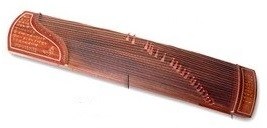About the guzheng


About the guzheng


The Guzheng古筝, or Zheng 筝, is part of the zither family and is one of the most ancient Chinese traditional musical instruments. The history of Guzheng can be traced back 2500 years to documents written in the Qin dynasty (before 206 B.C.) The Guzheng was originally called simply Zheng, but as the instrument developed an extended and ancient history the prefix “Gu” was added. “Gu” means ancient in Chinese and its combination with Zheng stresses not only the age of the instrument itself but also the potential the instrument has for having a substantial cultural place within a nation that has an extensive cultural past. The Guzheng has been a popular musical instrument in China since ancient times, and is considered one of the most important chamber as well as solo instruments of Chinese traditional music. Guzheng is also the precursor to Japanese koto, Korean kayagum, Mongolian yatag, and Vietnamese dan tranh, demonstrating the instruments rich multi-cultural history. Though the Guzheng has found a place in nations that share closely interwoven cultural pasts with China, the present study will focus explicitly on its role within China.
The modern Guzheng is a plucked, half-tube zither with 21 strings that rest on moveable bridges above a rectangular sound box. The sound box (or large resonating cavity), is made from wu-tong wood (paulownia tomentose or firmiana platanifolia). Other components of the instrument may be made from other woods, but these components are usually for structural and decorative purposes only. Guzhengs with 23 and 26 strings also exist, but are primarily used by advanced players. The pitch of a given string is determined by the position of the moveable bridges; in principle, these moveable bridges allow the instrument to be tuned to any number of desired scales. Traditionally, a pentatonic scale is used. The player produces sound on the instrument by plucking the strings with finger picks that are attached to the fingers of the right hand. The strings are struck just left (players left) of the string rest. On the opposite side of the bridges the player uses their left hand to apply pressure to the strings; this creates subtle vibrato effects and other ornamentations by bending the pitch upward and downward. Heptachord scales can also be obtained by skillfully applying pressure to certain strings.
In the present, the Zheng has developed a wider range, depth, and versatility. Musicians are constantly refining new playing techniques for the instrument. New generations of the Zheng musicians are broadening the scope of the Zheng and take it to a higher level. Since the mid-19th century, Zheng solo repertoire has been growing and evolving towards an increasing technical complexity. After the Cultural Revolution, the 1960’s revival of folk music also paved the way for the Zheng’s popular return. In the present, the Zheng has developed a wider range, depth, and versatility.
REFERENCES:
Cao Zheng (translated by Yohana Knobloch): 1983.
Han Mei: 2003. The New Grove Dictionary of Music and Musicians, 2nd edition, Vol. 27, P 802
Xiang SiHua: 1993
Yang YinLiu: 1981
Yuan JingFang: 1987
我国历来对古筝很推崇,古筝一直被认为是民族乐器中的瑰宝,雅俗共赏的奇葩,群声之祖,万乐之师。不但是我国人民对古筝情有独钟,世界上很多国家对古筝也非常欣赏,称古筝为神秘的乐器,称它弹奏出的乐曲为神奇的音乐。历朝历代,大量文学作品中都有关于古筝艺术的描写,这也证明了古筝在中国文化史当中的重要地位。
古筝的外形古朴典雅美观大方,音色优美圆润清丽明亮,具有极强的亲和力;音量也比较大,而且容易控制。所以,古筝有着相当出色的表现力和强烈的感染力,能充分表现民族风格浓厚的乐曲内容。用古筝弹奏出的乐曲,柔和优美,清丽和谐,余音绕梁三日不绝,深受人们的喜爱。古人和今人都有大量描写古筝艺术的文学作品和记载。当代,不但文学作品中有关于筝的描述,古装影视剧中更是有大量弹筝镜头出现。
--<<雅虎知识堂>>--


Copyright © 2009
updated on July 15, 2014